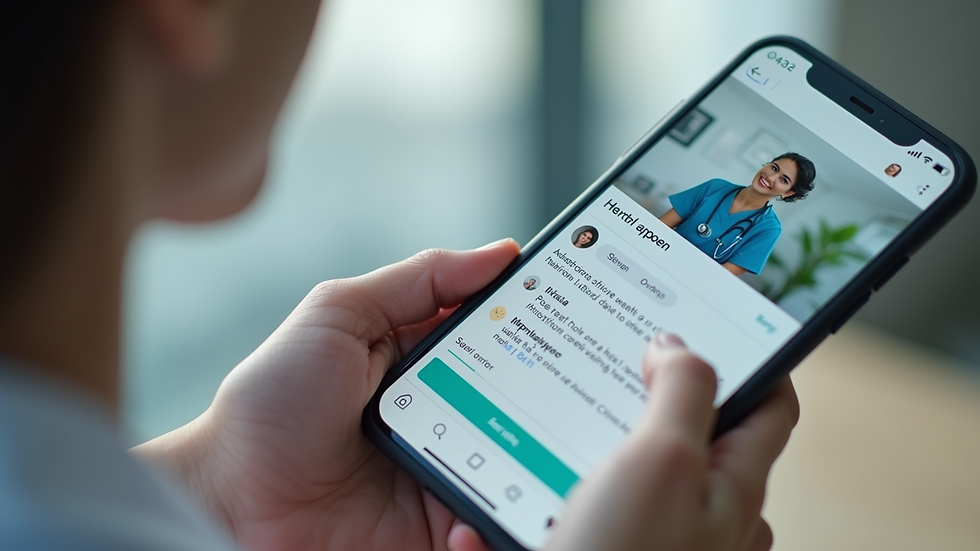Social Media Strategy for Healthcare Success
- Elizabeth Rodriguez
- 5 days ago
- 3 min read
In today’s digital age, healthcare providers must embrace social media to connect with patients, share valuable information, and build trust. A well-crafted healthcare social media strategy can improve patient engagement, enhance brand reputation, and ultimately lead to better health outcomes. This post explores practical steps and insights to help healthcare organizations succeed on social media platforms.
Building a Strong Healthcare Social Media Strategy
Creating an effective healthcare social media strategy requires understanding your audience, setting clear goals, and choosing the right platforms. Here are key components to consider:
Identify Your Audience: Know who you want to reach. Are they patients, caregivers, or healthcare professionals? Tailor your content to their needs and preferences.
Set Measurable Goals: Define what success looks like. Goals might include increasing patient inquiries, boosting appointment bookings, or raising awareness about health topics.
Choose Appropriate Platforms: Different platforms serve different purposes. Facebook and Instagram are great for patient engagement, LinkedIn works well for professional networking, and Twitter is ideal for sharing timely updates.
Develop a Content Plan: Plan a mix of educational posts, patient stories, health tips, and organizational news. Consistency is key to maintaining audience interest.
Engage and Respond: Social media is a two-way street. Respond promptly to comments and messages to build trust and show you care.
By focusing on these elements, healthcare organizations can create a social media presence that resonates with their community and supports their mission.

Key Tactics for Effective Healthcare Social Media Strategy
To maximize the impact of your healthcare social media strategy, consider these actionable tactics:
Use Visual Content: Images, infographics, and videos increase engagement. For example, short videos explaining common medical procedures or wellness tips can be very effective.
Leverage Patient Testimonials: Sharing real patient stories (with permission) builds credibility and emotional connection.
Host Live Q&A Sessions: Live sessions with doctors or specialists allow followers to ask questions in real time, fostering transparency and trust.
Promote Health Campaigns: Use social media to support public health initiatives like vaccination drives or awareness months.
Monitor Analytics: Track metrics such as reach, engagement, and click-through rates to understand what works and refine your strategy.
These tactics help healthcare providers stay relevant and responsive in a fast-changing digital landscape.
What is the 5 5 5 Rule on Social Media?
The 5 5 5 rule is a simple guideline to maintain balance and consistency in social media posting. It suggests:
5 Posts About Your Brand: Share updates about your healthcare services, staff, and achievements.
5 Posts From Others: Share relevant content from trusted sources like health organizations or news outlets.
5 Posts That Engage: Post interactive content such as polls, questions, or fun facts to encourage audience participation.
Applying this rule helps maintain a diverse and engaging content mix that keeps followers interested without overwhelming them.

Ensuring Compliance and Privacy in Healthcare Social Media
Healthcare organizations must navigate strict regulations to protect patient privacy and comply with laws such as HIPAA. Here are best practices to ensure compliance:
Avoid Sharing Patient Information: Never post identifiable patient details without explicit consent.
Train Staff: Educate employees on social media policies and the importance of confidentiality.
Use Secure Platforms: Choose social media tools that offer robust security features.
Review Content Before Posting: Implement a review process to ensure all posts meet legal and ethical standards.
Respond Carefully: When engaging with patients online, avoid giving specific medical advice publicly.
By prioritizing compliance, healthcare providers can build trust and avoid costly legal issues.
Measuring the Impact of Your Healthcare Social Media Strategy
Tracking the success of your social media efforts is essential for continuous improvement. Focus on these key performance indicators (KPIs):
Engagement Rate: Likes, comments, shares, and mentions indicate how well your content resonates.
Follower Growth: An increasing number of followers shows expanding reach.
Website Traffic: Monitor how many visitors come from social media to your website or appointment booking pages.
Lead Generation: Track inquiries or sign-ups generated through social media campaigns.
Sentiment Analysis: Assess the tone of comments and messages to gauge public perception.
Use analytics tools provided by social media platforms or third-party software to gather data and adjust your strategy accordingly.
For healthcare organizations looking to enhance their online presence, partnering with experts can be invaluable. A social media strategy healthcare service can provide tailored solutions that align with your goals and regulatory requirements.
Moving Forward with Confidence
Implementing a thoughtful healthcare social media strategy opens doors to meaningful patient connections and improved health communication. By focusing on audience needs, maintaining compliance, and measuring results, healthcare providers can harness the power of social media to support their mission and grow their impact. Start small, stay consistent, and watch your online community thrive.




Comments